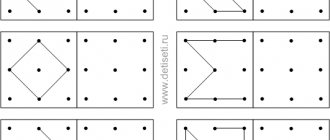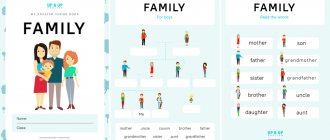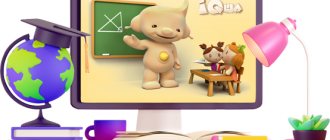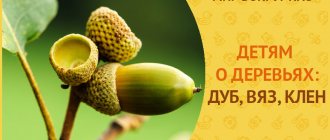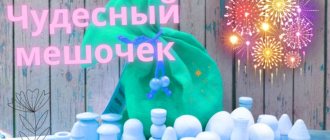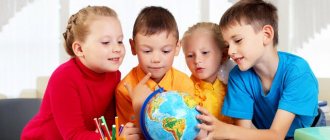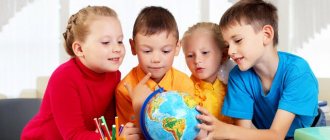What should a child entering first grade know?
Many parents think that in order for a child to successfully master classes and go to school, it is enough to teach him to write, count and read. Actually this is not true. The fact is that the child may not be psychologically ready to go to school.
Accordingly, over time, such children begin to lag behind their peers and quickly lose interest in tasks. Therefore, do not rush to burden your child with activities and give him impossible tasks. Everything should be in accordance with the age of the baby. Of course, now the age at which a child is sent to school has been somewhat reduced. Therefore, not all children are ready to go to first grade and fully study.
A child going to 1st grade should know:
- What is his name, your last name
- State your age and date of birth
- In addition, he should know his mother’s name and patronymic, last name, place of work
- He should know the same information about his dad.
- The child must tell if he has a sister, how old she is and what her name is
- Give your home address, as well as the country and city where you live
You need to ask the child if he wants to go to school, if he likes to study and learn. If a child enjoys going to school, wants to learn, and his intellectual level corresponds to a first-grader, he can be taken to school.
First graders
Development of logic and thinking
Logical thinking is very useful for a child from the very first days of school. Logic helps to solve various problems, including mathematical ones. Having this knowledge, the child will feel much more confident in life, learn to think, look for patterns, and draw conclusions. It is advisable to start with the simplest exercises, gradually complicating them.
Analogies
The purpose of this task is to teach the child to establish a logical connection between words, train flexibility of thinking and draw analogies. To do this, you need to divide a sheet of paper into two columns, and write a few words in each column. Then you need to invite the child to study the words in the right column and establish a logical connection between them.
When the child understands what the words in the right column have in common, he should be asked to study the words located in the left column and choose from them those words that match the words from the right column.
The main thing is that the child can explain why he chose this particular word and what unites all the words he chose.
For example, in the left column the words are given: currant, berry, pan. The words in the right column are: stove, soup, spoon, dishes, cook. The word “saucepan” fits the words from the right column, since this is a dish, it sits on the stove, in which the cook cooks soup and stirs it with a spoon.
Eliminating unnecessary things
The purpose of this task is to teach the child to generalize and classify various concepts. The child must be offered a list of words (at least 4), of which one word does not fit in meaning with the others. The kid must find the extra word and explain why he chose it. The child needs to complete about 10 tasks at a time.
For example, the words are given: shoes, boots, boots, sandals, felt boots, laces. In this series, the word “laces” is superfluous, because these are not shoes.
Speed of thinking
This task teaches the child to see the whole picture as a whole, to put together a complete image from details. The purpose of this exercise is to train your thinking speed.
The child needs to be shown words whose letters are missing. In place of the missing letter there is a dash; the number of dashes is equal to the number of missing letters. In three minutes, the child needs to form as many words (singular nouns) as possible.
It’s not scary if the baby doesn’t understand what word can be formed from the remaining letters. You can skip this word and move on; the main thing here is not only correctness, but also speed.
For example, on paper it may be written: g-ra, z-m-k, r-ba, o-n-. The child must name the words as quickly as possible: mountain, castle, fish, window.
Decoding anagrams
Anagrams are words whose letters are rearranged in random order. The child must identify the encrypted word. This task helps the child see the whole picture from the details.
For example, a child is shown a card on which it is written: chnetie, slot, aogvolmolko. The child must guess as quickly as possible that these are the words reading, table, puzzle.
Exercises on Russian language and speech development
Developmental tasks for children 6-7 years old must necessarily include exercises in the Russian language and speech development. At this age, a child must know the alphabet, be able to put letters into words, be able to write (in block letters), and also be able to clearly, distinctly and relatively competently express his thoughts and opinions.
To study the alphabet, you can use cubes, special cards with words and letters, cards with pictures, and printouts with ready-made small exercises.
Missing letters
The child needs to print pictures of animals and objects with their names on a sheet of paper. In names, several letters must be omitted. The kid must understand who is located in the picture and fill in the missing letters in the words.
For example, on the left side of the sheet you can place a drawing of a dog, and on the right side you can place the inscription “s... b... ka.” The child can fill in the missing letters “o” and “a” right there on the sheet with a pencil or pen. At one time, the child must complete about 10 such tasks.
Unravel the words
You need to print the pictures on a sheet of paper and sign them, mixing up the letters. The child needs to guess which word is encrypted under the picture.
For example, under a picture of a chamomile, you need to sign “daisy”. This exercise trains attentiveness and intelligence, and also helps the child navigate how words are constructed.
Speech development exercise
This developmental exercise for children 6-7 years old is performed in the form of a conversation. The child needs to be asked a number of questions in order to clarify his ideas about a particular subject. For example, you can ask about what you can do at the table and why it is needed. The child must tell him that he can sit, eat, play, and read at the table. This way you can describe any objects.
You should ask your child what a scooter, a meat grinder, an airplane, a vacuum cleaner are. The child must guess why these items are called that way and explain why they are needed and how people use them. The baby should be able to generalize objects, for example, a table and a chair are furniture, and a lion and a cat are animals.
It is advisable to talk with your child more often and ask his opinion on any issue - the answer does not have to be correct , the child will show his imagination and make his own assumptions. The main thing is to teach your child not to be afraid to speak out.
Developmental exercises for children 6-7 years old allow parents to prepare their child for school without stress and additional costs for tutors. Completing the assignments will not take much time and will help your child gain basic skills for further study at school.
Quiz about cartoons for 5 years old
With the help of a quiz it is easy to check how well children know the plot of cartoons and what they pay attention to. In addition to the proposed questions, children can be read a description of the cartoon - and they must say its name themselves or choose from interesting options.
- What cartoon was Princess Jasmine in? (Aladdin)
- How many robbers have stood up to Alibaba? (40)
- What was the name of the hippopotamus from the cartoon Madagascar? (Gloria)
- The big green character who lived in the swamp is... (Shrek)
- Who is always in a hurry to help? (Chip and Dale)
- How many nephews did Scrooge McDuck have? (Three)
- What was the name of the disgruntled octopus, SpongeBob's acquaintance? (Squidward)
- In which cartoon do puppies come to the rescue? (PAW Patrol)
- How many Dalmatians were there in the popular cartoon? (101)
- What was the name of Cheburashka's best friend? (Crocodile Gena)
- The name of the horse from the cartoon about 3 heroes... (Juliy)
- Who can move around the city on a web? (Spiderman)
- What was the name of the moose from Smeshariki? (Losyash)
- What is the name of the cartoon where a squirrel tried to get a nut out of ice? (Glacial period)
- What was the name of the big black cat from the cartoon about Mowgli? (Bagheera)
Riddles for the development of thinking of 5-6 year olds
The purpose of riddles is not just to formulate questions on a certain topic, but also to have fun. We have selected the top 15 interesting tasks for kids that can test their general knowledge.
- Jumps through the trees and hides nuts. (Squirrel)
- A faithful friend for a person, will become a running companion. (Dog)
- A fluffy ball, a ball of wool. Drinks milk and purrs easily. (Cat)
- The nose is a snout and the tail is a hook. (Pig)
- Butts and jumps, hides a lot of fur. (Goat)
- I am stubborn, small, related to any horse. (Donkey)
- It takes five hours for me to crawl a step. (Turtle)
- Throw in meat, onions, potatoes. Eat the pan, not the spoon. (Soup)
- Striped, scarlet, everyone loves me very much. (Watermelon)
- Not an easy neighbor, but a real mother hen. (Chicken)
- A beep will notify everyone when there is boiling water. (Kettle)
- A stick with a thread and a hook, with it you will be a fisherman. (Fishing rod)
- It drives and buzzes, in a hurry to take everyone home. (Car)
- Let's go on a trip and put at least a bear there. Small and large, they store expensive things. (Suitcases)
- We put the earhooks on the small ears. (Glasses)
Math classes
Developmental tasks for children 6-7 years old must necessarily include math exercises. At this age, the child should already have a good knowledge of forward and backward counting to 10, understand the operations of increasing or decreasing, and be able to restore the sequence of numbers if one or more numbers are missing.
The child also needs to be taught to compare numbers; he must understand concepts such as “more”, “less” or “equal”. It is also important to be able to compare objects by length, width and height, as well as know the name of geometric shapes.
Learning to count
On a piece of paper, write a number series with missing numbers. The child's task is to fill in the empty cells with the appropriate numbers. For example: 2, …, …, …, …, 7, 8, 9, 10; 6, …,…,…,10.
It is advisable to complete about 10 such tasks at a time. In this case, it is desirable that different numbers be skipped each time. It is important to teach your child not only to count forward, but also to count backwards. You can ask your child to fill in the blanks for numbers from 10 to 4 or from 6 to 2. All tasks should be different. It is important that the child be able to reproduce a sequence of numbers, starting from any number.
Simple geometry
This exercise helps the child learn simple geometric shapes, helps to understand what width, length or height is, and develops imagination and spatial thinking.
The child needs to be shown a sheet of paper on which different geometric shapes are located. The child should be able to find a square, circle, triangle, oval, trapezoid and parallelepiped in a picture. It is important that the baby understands which of the figures is larger, taller, wider or longer.
You can cut out different shapes from colored paper and invite your child to sort them by size, color or name, and then count which shapes there are more and how much more. This task helps you learn to categorize objects and analyze the results.
Say it right
This exercise is carried out in the form of a game. The child must be asked 10 questions about mathematics. In the allotted time, the child must give as many correct answers as possible.
Examples of questions for the game:
- Name the neighbors for the number 4.
- What number is 1 greater than 3?
- Name the numbers from 4 to 9.
- Name the days of the week from Thursday to Thursday.
- How many days are there in a week?
- How many months are there in a year?
- Name the fifth month of the year.
- Name the third month of the year.
- Say the numbers in reverse order from 10 to 5.
- Decrease the number 4 by 2 units.
To make it more interesting, you can come up with special prizes for your child for winning (candies or small toys). For example, for 8 correct answers the prize will be candy, and for 10 correct answers a small toy.
